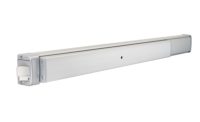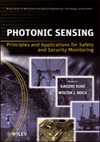Exit Devices Best Players on Field

Adding lighting technologies turns an exit device into an illuminated guide to safety. Photo courtesy ASSA ABLOY Door Security Solutions
Sports fans like to engage in hypothetical discussion that asks if a team were started anew, who would be the ideal player to build around. A list of qualifications is usually referenced in the selection: strength, durability, multi-dimensional, plays good defense and improves the performance of other teammates.
Security professionals no doubt play a similar version of this game, asking themselves and colleagues, what is the one component a security system can be built around.
The sports discussion is open to debate. The security version, however, is easily put to rest. Who can possibly pick anything other than the exit device?
BUILDING CONTROLS
The exit device is the five-tool player of a building control system— it provides strong security, is both durable and versatile, offers electromechanical features and improves overall system performance. Most importantly, the exit device serves as a convergence point where security combines with life safety.It turns out to be an All-Star business player.

Exit devices are the All-Star players. They serve as a convergence point where security combines with life safety.
SECURITY
The brute strength of an exit device makes it a crucial part of any security system. It can be combined with mortise or bored locks on perimeter doors to form a strong defensive system against unwarranted entry. A standard mortise exit device equipped on an exterior doorway will allow unimpeded egress, while simultaneously impeding intrusion from the outside of the building.A good measure of an exit device’s ability to provide dependable security is how well it performs in ANSI/BHMA static load tests. The Grade 1 standard requires exit devices to withstand 400 lbs (542 N) of static force. Generally, the average person exerting all their strength while pulling on a door handle can apply approximately 100 to 200 lbs (136 N to 271 N) of static force. An exit device securing a door prone to vandalism or other abusive forces should be designed to resist extreme static forces. In other words, when a would-be intruder tries to rip a door open by pulling on the handle, the lock should hold steadfast.

A mortise exit device combines security and life safety. Photo courtesy ASSA ABLOY Door Security Solutions
DURABILITY
Since exit devices tend to be hardware workhorses subjected to heavy use, durability is an important feature. A good way to judge the durability of an exit device is to look at how well it performs in ANSI/BHMA cycle testing. The Grade 1 standard is 500,000 cycles. An exit device destined for a heavily trafficked opening should cycle test well beyond the minimum ANSI/BHMA standard. A durable exit device should spend little or no time on the disabled list. It’s not uncommon to find exit devices that can test to millions of cycles.VERSATILITY
An exit device can also offer features not possible on other hardware. Exit alarms, dogging functions, egress lighting—the exit device is the Swiss army knife of hardware. Delayed egress alarms sound an audible alert when the push bar is depressed and then waits a set amount of time before unlatching the door. The dogging function allows the latch to be set in a retracted position, enabling silent operation of the door.Electroluminescent, photoluminescent and laser lighting technologies can be incorporated into the rail or push bar, turning a simple exit device into a highly illuminated guide to safety. The inclusion of these features can enhance the functionality of the entire doorway.
ELECTROMECHANICAL FEATURES
Include a few wires and switches on an exit device and its overall value as a security component soars. Because they are found on many perimeter doorways, exit devices can be an integral part of an access control system. Electromechanical versions offer functions that can tie directly into the system to provide monitoring and control of doorways.Remote latch retraction allows the exit device to be locked or unlocked from a remote location while simultaneously dogging or undogging the push rail.
Latchbolt or push rail monitoring switches allow independent monitoring of the doorway and can be used to detect egress or tampering, sound an alarm, signal a remote location or de-energize an electromagnetic lock.
An electric latch retraction feature is ideal for high traffic egress doors that require access control. Once retracted, the door functions in a push/pull manner. An exit device equipped with electric latch retraction can be dogged for momentary ingress and egress and is commonly used in conjunction with an automatic door operator. The device can be dogged continuously on fire-rated devices that are tied into the building’s fire detection system. When de-energized, the push becomes undogged and re-latches the door.
SYSTEM PERFORMANCE
With its ability to handle so many functions, the exit device improves the overall performance of a building’s control system. Tie a fire alarm into an exit device with built-in lighting technologies and the emergency exit becomes an illuminated pathway to safety. Include a monitoring switch, and the exit device gives a security system the ability to keep a watchful eye on exterior doorways. Add a dogging function and the exit device improves acoustics of a theater or library.The exit device plays many roles and plays them well. These abilities make it an ideal choice as the most valuable player among security/life-safety system components.
SIDEBAR: Electronic Access Add Abilities
For door controls, new generation electronic access control systems add dimension to door protection. Recently, numerous companies have enhanced their systems. A case in point: the PremiSys access control system from IDenticard has an option for facilities of every size.Key features of such solutions can include:
Dynamic mapping -- it contains dynamic mapping to monitor alarms, relays, doors and alarm acknowledgements through a floor plan/graphic map interface. Dynamic mapping should be easy to configure; you simply drag icons from the site tree and drop them onto the map.
Antipassback -- The system should prevent reusing cards to access the same area within a specified period of time, or until the card has been used to exit the area. Areas-based antipassback also incorporates occupancy counts.
ADA compliance -- Extended door time is assigned to cardholders with disabilities who require it.
SIDEBAR: Special Risks: Fire-rated Doors
How can door hardware, door position switches, and other access control apparatus be installed onto fire-rated doors?The answer should be very carefully thought out. Doors that are fire-rated are designed and built to provide a barrier against the spread of a fire from one room/area to the next. Any modification to a fire-rated door, such as drilling, channeling, or installing a magnet for a door position switch, will likely violate that door’s fire rating in the eyes of the authority having jurisdiction.
Specialized hardware, such as door hinges with built-in position switches, can be used successfully on fire-rated doors. The key is to know what doors are fire rated in a particular installation, and to approach the application of access devices for those doors so that the door remains intact and is not modified in any way.
Looking for a reprint of this article?
From high-res PDFs to custom plaques, order your copy today!








